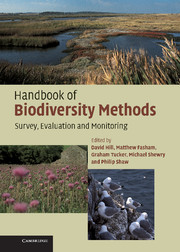Book contents
- Frontmatter
- Contents
- Preface
- Acknowledgements
- Part I Planning
- Part II Habitats
- Part III Species
- 9 Introduction to species assessment
- 10 General principles and methods for species
- 11 Fungi
- 12 Lichens
- 13 Bryophytes
- 14 Aquatic macrophytes and algae
- 15 Vascular plants
- 16 Dragonflies and damselflies
- 17 Butterflies
- 18 Moths
- 19 Other terrestrial invertebrates
- 20 Aquatic invertebrates
- 21 Fish
- 22 Amphibians
- 23 Reptiles
- 24 Birds
- 25 Bats
- 26 Other mammals
- Appendix 1 Monitoring and reporting obligations under international conservation agreements
- Appendix 2 Relationship between BAP Priority Habitat and Broad Habitat categories and Habitats Directive nomenclature
- Appendix 3 Annotated list of key references for plant identification
- Appendix 4 Determining appropriate quadrat size for vegetation sampling
- Appendix 5 The relocation of permanent plots
- Appendix 6 Equipment required for undertaking different types of survey
- Recommended sources of further information
- References
- Glossary
- Index
12 - Lichens
Published online by Cambridge University Press: 01 September 2010
- Frontmatter
- Contents
- Preface
- Acknowledgements
- Part I Planning
- Part II Habitats
- Part III Species
- 9 Introduction to species assessment
- 10 General principles and methods for species
- 11 Fungi
- 12 Lichens
- 13 Bryophytes
- 14 Aquatic macrophytes and algae
- 15 Vascular plants
- 16 Dragonflies and damselflies
- 17 Butterflies
- 18 Moths
- 19 Other terrestrial invertebrates
- 20 Aquatic invertebrates
- 21 Fish
- 22 Amphibians
- 23 Reptiles
- 24 Birds
- 25 Bats
- 26 Other mammals
- Appendix 1 Monitoring and reporting obligations under international conservation agreements
- Appendix 2 Relationship between BAP Priority Habitat and Broad Habitat categories and Habitats Directive nomenclature
- Appendix 3 Annotated list of key references for plant identification
- Appendix 4 Determining appropriate quadrat size for vegetation sampling
- Appendix 5 The relocation of permanent plots
- Appendix 6 Equipment required for undertaking different types of survey
- Recommended sources of further information
- References
- Glossary
- Index
Summary
The principles behind lichen survey and monitoring techniques are basically identical to those for other groups of lower plants. However, there are some considerations peculiar to lichen survey and monitoring, which must be considered when designing a suitable programme.
Many species of conservation importance are very scarce; some are known from only a single site. In the case of lichens, a single site can be something as small as a single tree, a rock or a tree stump. Many species are relict, and under prevailing conditions cannot colonise new habitats. The sites themselves may be small relics of larger areas of ancient habitat with long continuity and a history of minimal adverse disturbance. Thus the necessary conditions in which the species can persist may only occur in one location or in a series of distinct fragments. By definition, a relict species cannot colonise distant sites even if conditions are suitable. The destruction of ancient, unrecreatable habitat is an important cause of lichen rarity, but far from the only one.
Other lichens rely on extremely localised habitats. For example, Gyalideopsis scotica requires decaying bryophyte material on specific soils near the summits of a few Scottish mountains. Cladonia botrytes grows on dead pine (Pinus spp.) stumps at a particular stage of decay.
Lichens may therefore require ephemeral scarce habitats or ancient scarce habitats; in either case, their habitat requirements are often very specific and any alteration of the conditions under which lichen species will grow will frequently adversely affect the health of the colony.
- Type
- Chapter
- Information
- Handbook of Biodiversity MethodsSurvey, Evaluation and Monitoring, pp. 279 - 287Publisher: Cambridge University PressPrint publication year: 2005

